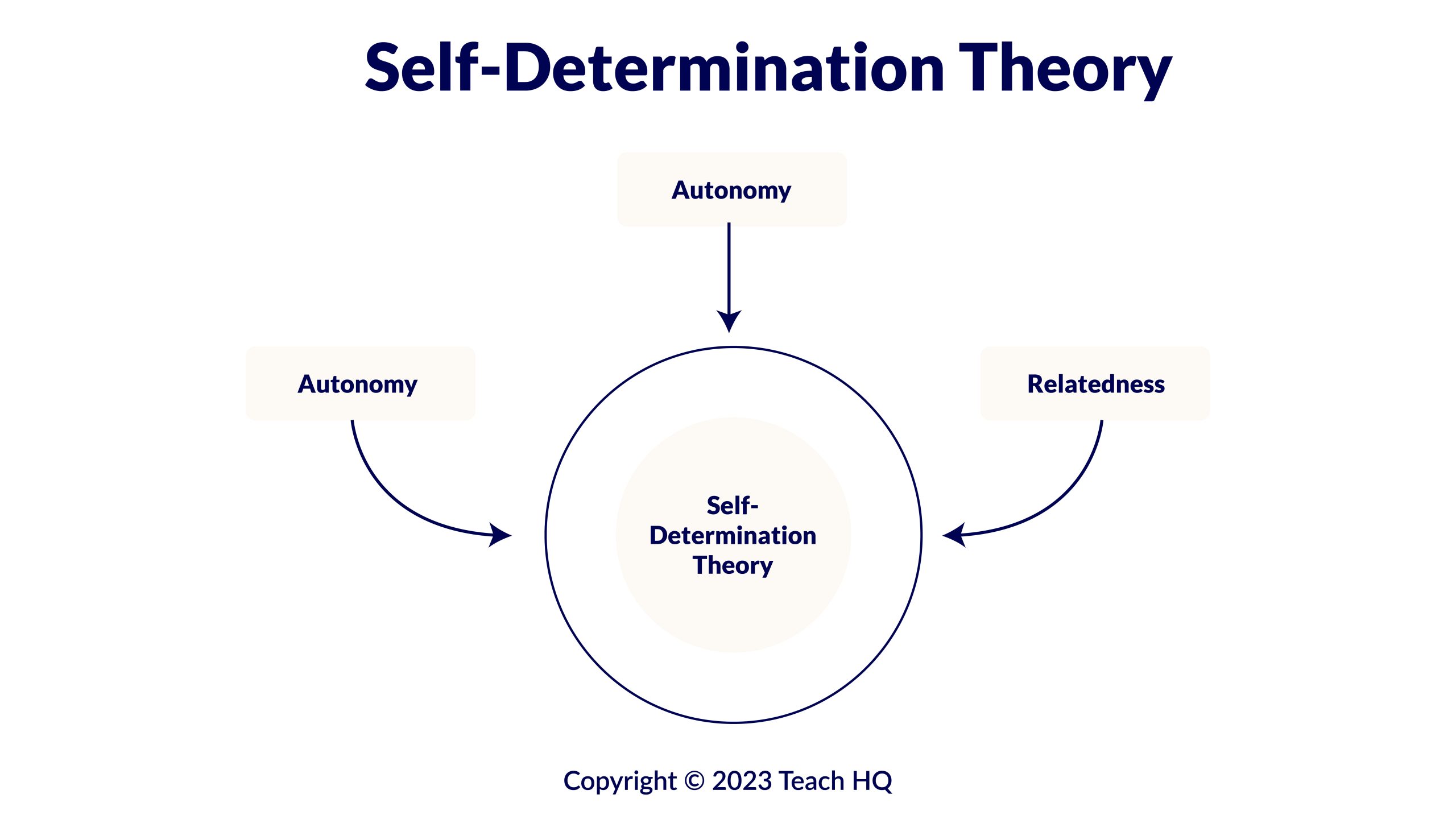The Self-Determination Theory was developed by Edward Deci and Richard Ryan in the late to mid-1980s. At the time, it was regarded as a breakthrough in understanding human motivation and behaviours. In terms of education, SDT helps teachers address challenging issues, such as lack of motivation and attention in the classroom. Aside from that, it also builds a useful learning framework that encourages students to aim high and achieve more.
Self-Determination Theory in Education
Self-Determination Theory operates on three main principles, which all contribute to efficient human functioning and motivation. The core principles are:
- Autonomy: This suggests that individuals naturally want to make their own choices and have a say in their actions. In an educational setting, giving students this autonomy might involve providing more (or different) assignment choices.
- Competence: Competence refers to the psychological need to interact with the environment effectively. This principle suggests that students are more motivated when they feel they have the necessary skills and depth of understanding to complete tasks well and successfully.
- Relatedness: This links to a need to feel connected to others. In a school, this might involve collaborative learning or encouraging teamwork to promote a greater sense of ‘community.

Origin and Development
Psychologists Deci and Ryan's work has been seminal in reshaping our understanding of human motivation, not just in educational psychology but across various disciplines, including organisational behaviour and healthcare. The theory has evolved significantly over the years, enriched by empirical studies and adapted for specific contexts, including education. Schools and educational institutions are increasingly realising the potential of SDT in fostering an environment conducive to teaching and learning, a perspective endorsed by numerous studies.
The Importance of Self-Determination Theory
Understanding the role of Self-Determination Theory (SDT) in educational settings is crucial for educators committed to delivering outstanding educational outcomes and complying with educational standards. Here are some of the areas where SDT can make a tangible difference.
Enhancing Student Engagement
One of the most compelling benefits of SDT is the potential for enhancing student engagement and interest in learning. A study published in the "
Journal of Educational Psychology" highlighted that classrooms that use SDT strategies witness a substantial improvement in student engagement (
Skinner, Furrer, Marchand, & Kindermann, 2008). It proves that by introducing choice, relevance, and meaningful tasks, a sense of ‘autonomy’ is created – and this enhances attendance and emotional and cognitive engagement.
Improving Academic Performance
Employing SDT principles can also positively impact academic performance. Research indicates a strong link between autonomy, competence, and relatedness principles and improved academic outcomes (
Jang, Reeve, & Deci, 2010).
Fulfilling Regulatory Compliance
Understanding and applying SDT can consistently help schools and educators align with key educational standards and frameworks, such as those produced by Ofsted.
Case Study: Implementing SDT in a Classroom Setting
Mr Smith, a history teacher at a school in Manchester, observed low engagement and academic performance among his Year 10 students at the beginning of the academic year. After studying SDT, he introduced changes designed to improve autonomy, competence and relatedness in learning.
His approach covered the three core principles:
- Autonomy: He started by giving students more choice in assignments, allowing them to select from various historical periods for their projects.
- Competence: Feedback sessions were introduced where students could discuss their work, identifying strengths and areas for improvement.
- Relatedness: Implemented group-based assignments to encourage community and student teamwork.
Outcomes
During the academic year, Mr Smith’s class showed a big improvement in both learning attitude and performance. A student survey confirmed higher levels of intrinsic motivation, and the end-of-year exam results indicated an improvement of 15% YOY. Mr Smith's approach was found to align with the Ofsted framework, which calls for an inclusive learning environment tailored to the needs of students. His strategy became a model for other teachers in the school to follow.

Practical Guidelines for Educators
Below are practical suggestions for improving your educational environment in line with SDT principles.
Fostering Autonomy
- Choice provision: Offering students multiple avenues for expressing their understanding can be useful. For example, instead of a standardised test, consider providing an option to submit a project, an oral presentation, or a written report. Let them choose.
- Scaffolding independence: Gradually introduce responsibilities that enable students to work independently. Use guided activities that lead to self-directed tasks.
Building Competence
- Formative assessments: Integrate assessments that are developmental and provide room for feedback. These should be focused on identifying a student’s current understanding but promote future improvement.
- Feedback: Always give individual (and specific) feedback that is both relevant and constructive. For example, focus on both strengths and areas for future improvement. This will ensure a student feels competent but able to respond to delegated goals.
Nurturing Relatedness
- Establish a classroom culture: Create an atmosphere where students feel safe, heard, and respected. Use circle time or class meetings to discuss classroom issues and celebrate achievements.
- Peer collaboration: Encourage activities that require peer interaction and teamwork. Group projects or peer tutoring effectively promote a sense of relatedness among students.
Using SDT Principles to Promote Sustainable Improvement
The long-term success of SDT in an educational context doesn't occur overnight. It requires thoughtful planning and a sustained commitment. Here is a suggested strategy/framework.
Integrating into Curricula
- Curriculum audit: Conduct an audit of your existing curriculum. Identify areas where SDT principles can be seamlessly integrated.
- Interdisciplinary approach: Collaborate with other subject leaders to create cross-curricular activities and opportunities.
- Outcome-based objectives: Align the curriculum with objectives that encourage independent learning.
Establishing School Culture
- Staff training: Develop CPD (Continuing Professional Development) training that enables teachers to understand and implement SDT principles.
- Community engagement: Involve parents and community stakeholders in understanding the importance of SDT. This will create an awareness beyond the classroom.
- Continuous monitoring and feedback: Establish metrics and KPIs to measure the effectiveness of SDT principles. Adapt and refine strategies based on ongoing assessments.
In Summary
The self-determination theory (SDT) leads to improved learning motivation and better outcomes across student learning communities, according to the latest research studies. Using the right tools and resources to support self-determination can have a dramatic and lasting impact on performance and achievement. We encourage educators to implement the actionable steps in the preceding sections to integrate SDT into both curricula and broader school culture meaningfully.
Recommended Reading & Resources


